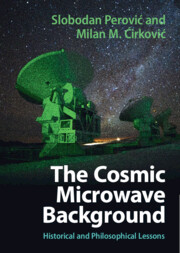Book contents
- The Cosmic Microwave Background
- The Cosmic Microwave Background
- Copyright page
- Epigraph
- Contents
- Acknowledgments
- Introduction
- Part I Physical cosmology: A brief introduction
- 1 Physical cosmology from Einstein to 1965
- 2 The “great controversy” (1948–1965) and epistemological issues it raised
- 3 Hot Big Bang and λCDM
- Part II Discovery of the CMB and current cosmological orthodoxy
- Part III What constitutes an unorthodoxy? An epistemological framework of cosmology
- Part IV Moderate unorthodoxies: The CMB with the Big Bang
- Part V Radical unorthodoxies: The CMB without the Big Bang
- Part VI Formation of the orthodoxy and the alternatives: Epistemological lessons
- Part VII Other philosophically relevant aspects of the CMB
- Book part
- Notes
- References
- Index
3 - Hot Big Bang and λCDM
from Part I - Physical cosmology: A brief introduction
Published online by Cambridge University Press: aN Invalid Date NaN
- The Cosmic Microwave Background
- The Cosmic Microwave Background
- Copyright page
- Epigraph
- Contents
- Acknowledgments
- Introduction
- Part I Physical cosmology: A brief introduction
- 1 Physical cosmology from Einstein to 1965
- 2 The “great controversy” (1948–1965) and epistemological issues it raised
- 3 Hot Big Bang and λCDM
- Part II Discovery of the CMB and current cosmological orthodoxy
- Part III What constitutes an unorthodoxy? An epistemological framework of cosmology
- Part IV Moderate unorthodoxies: The CMB with the Big Bang
- Part V Radical unorthodoxies: The CMB without the Big Bang
- Part VI Formation of the orthodoxy and the alternatives: Epistemological lessons
- Part VII Other philosophically relevant aspects of the CMB
- Book part
- Notes
- References
- Index
Summary
In this chapter, the two main ingredients of the contemporary cosmological paradigm, or the new standard cosmology, are initially presented as a thought experiment that brings us back to the initial singularity from which the physical universe sprang. The thought experiment follows the trajectory of the contraction of matter and radiation, darkening galaxies, and ever hotter universe to the first hundreds of seconds when a violent inflation of the universe took place that we can understand speculatively and perhaps observe indirectly through the structure of gravitational waves. After 300,000 years of expansion of the universe, very energetic photons disrupted positively charged nuclei and negatively charged electrons in forming atoms. At that point, the atoms were formed, and photons scattered off, traveling through space and slowly losing energy due to expansion of the universe. The structures (stars and galaxies) started forming. The accelerated, rather than uniform, expansion of the universe and dark energy driving it were postulated in 1998. This feature is not as established as the Hot Big Bang model, but observational evidence is accumulating. The chapter provides a box with the basic physical elements of the new standard cosmological model.
Keywords
- Type
- Chapter
- Information
- The Cosmic Microwave BackgroundHistorical and Philosophical Lessons, pp. 13 - 16Publisher: Cambridge University PressPrint publication year: 2024



